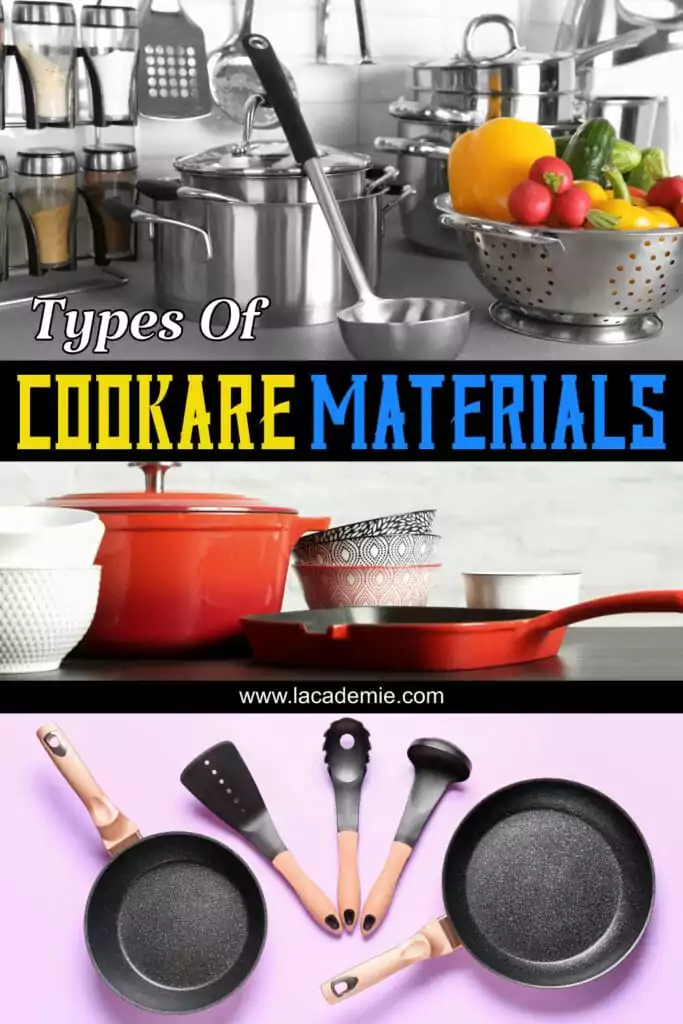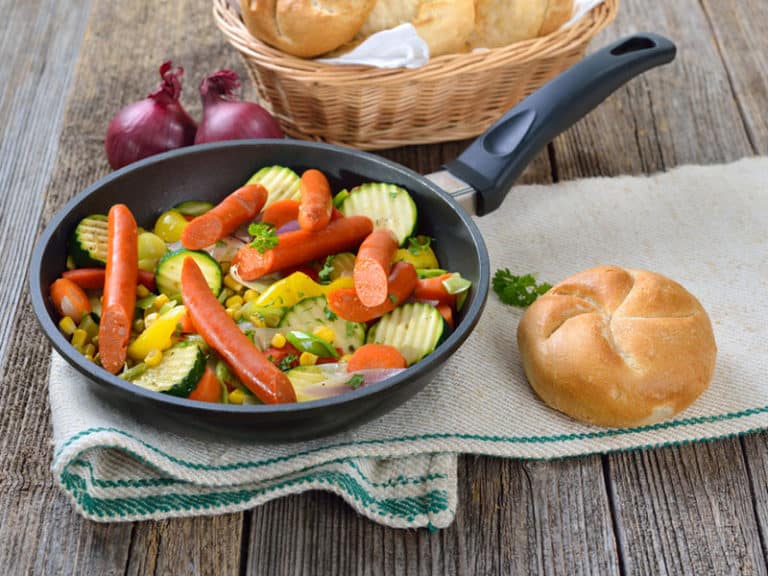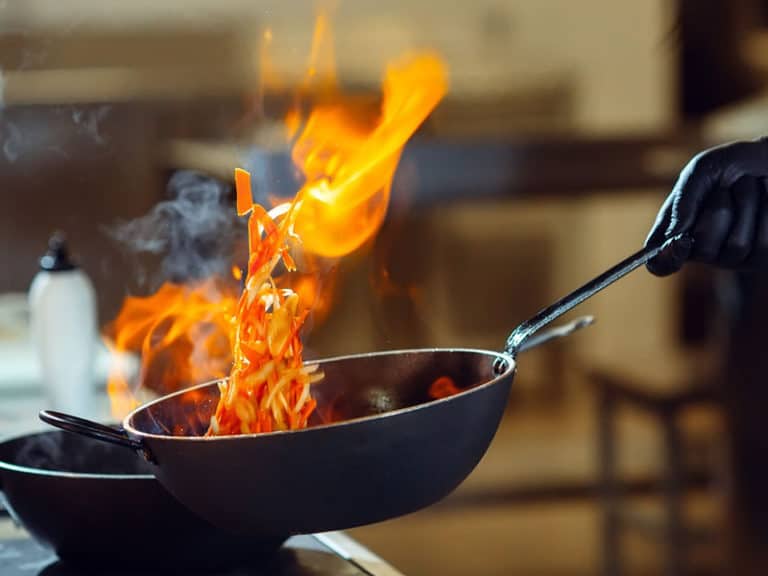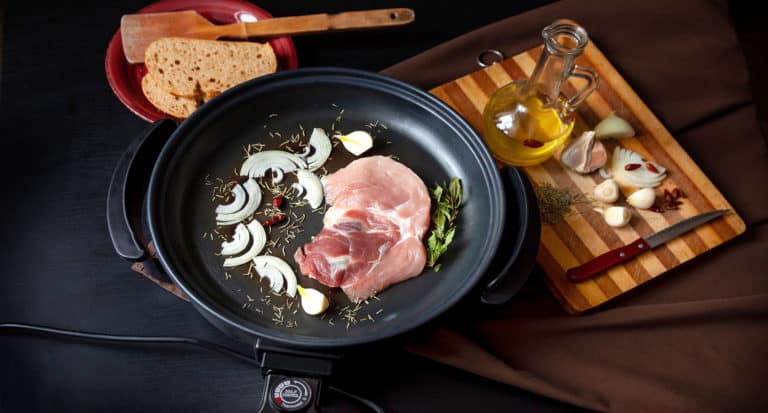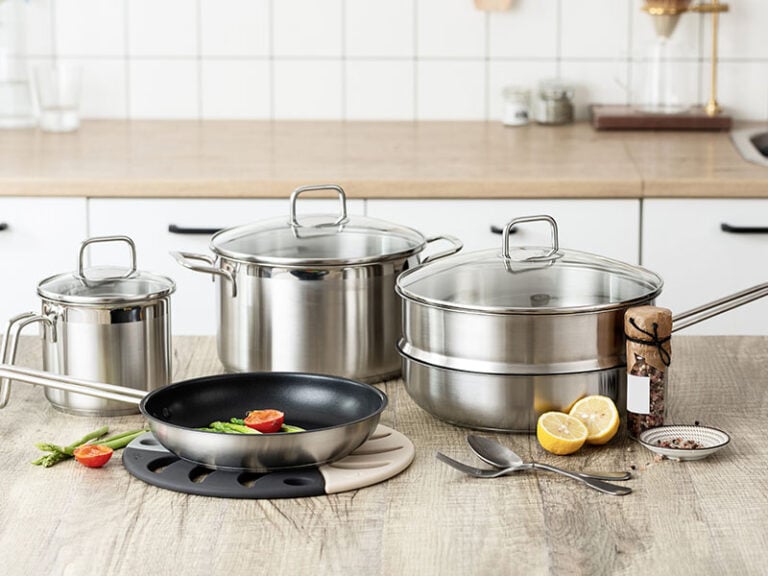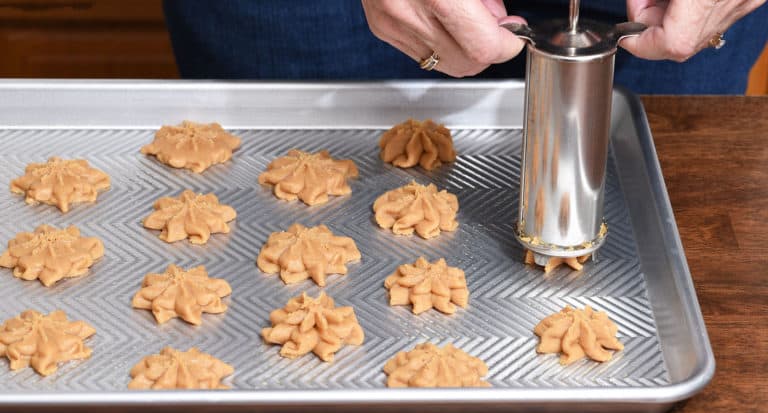How many types of cookware materials do you have? For the average home cook, my guess is three to four. At the moment, that may be enough. However, I bet that you won’t want to stop there if cooking is your passion, right?
If the answer is a resounding yes, then this post is exactly what you’ve been waiting for. Learn more about various types of cookware materials and add some to your collection today!
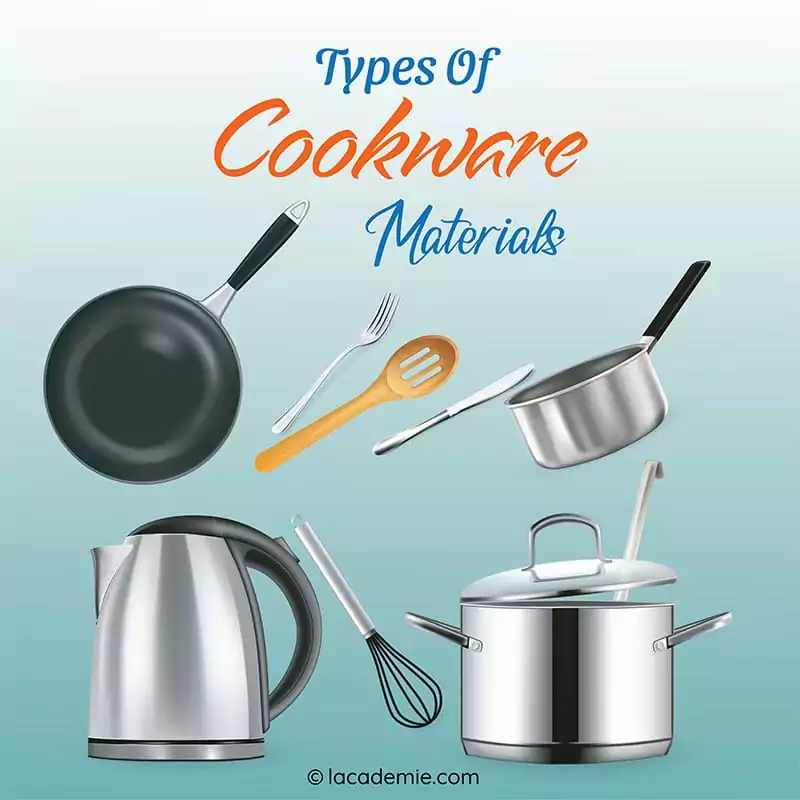
15 Most Popular Cookware Materials You Need To Know
Yes, my friend, you didn’t read it wrong. There are 15 cookware materials for you to discover, each of which is best suited for particular recipes and ingredients. For the sake of comparing, here’s a detailed chart to summarize their essential characteristics.
8 Phenomenal Metal Materials For Your Kitchen
Metal is the core material used in producing cookware, thanks to its durability. In this section, let’s explore which metal makes the best accompaniment for your lovely home kitchen.
1. Cast Iron
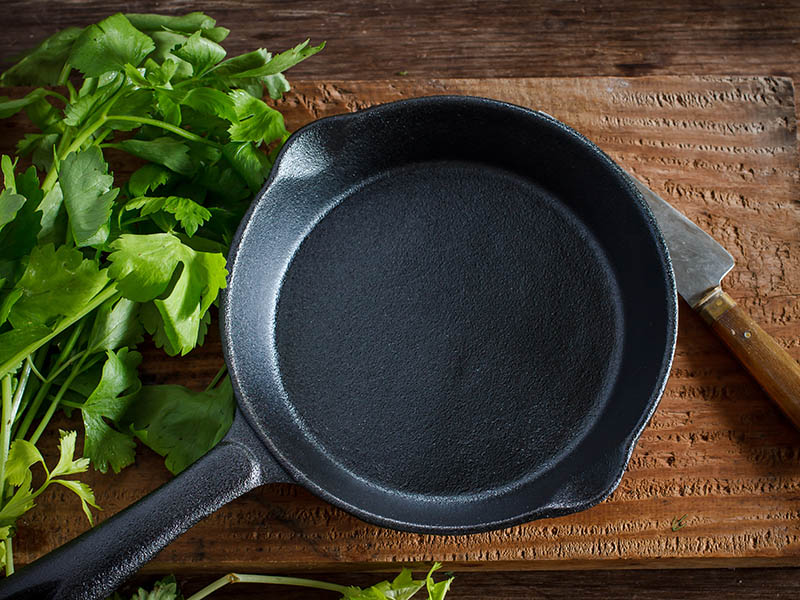
Cast iron is the definition of an old-but-gold material. Cast iron cookware is extremely versatile, great at retaining heat, and most importantly, is built to last. And you also have tons of recipes to cook with a cast iron skillet.
With an iron content of 96 to 98 percent and 2 to 4 percent of carbon, dents and chips are out of the question.
One important thing to remember when cooking with anything made out of cast iron is you’ll need to “season” it first. To be more exact, you have to coat the surface with a layer of cooking oil or fat (any type will work, but I prefer one with a high heating point).
By doing this, you practically hit two birds with one stone. First, your cookware will become nearly non-stick, which adds a lot to the ease of usage. More importantly, this “seasoning” layer will protect the material from rust and give it a rustic, old-school appearance.
A well-seasoned cast-iron pan will last for years and can be passed down from generation to generation. Its unmatched durability makes the iron-carbon hybrid a popular choice for commercial kitchens.
If you’re looking for a decent cast iron frying pan, Victoria Cast Iron Skillet Large Frying Pan With Helper Handle is an excellent choice. The skillet is pre-seasoned with non-GMO flaxseed oil, so you can start using it right out of the box.
In addition, Lodge Cast Iron Skillet with Red Silicone Hot Handle Holder is another all-rounded 10.25-inch option.
Pros
- Versatile use. You’ll see this material on numerous kinds of cookware, from dutch ovens, grills, skillets, woks, to frying pans and waffle irons.
- Durable. So long as you take care of it the right way, you can expect a lifetime (or more) of usage.
- The surface isn’t prone to scraping, so you can use any kind of utensil.
- Generally comes at an affordable price.
- This material will become non-stick when properly seasoned.
- Once heated up, cast iron can easily stay at a high temperature.
Cons
- Can be tricky to maintain. Without proper care, it might rust, chip, or even crack.
- Require regular seasoning. It’s recommended to season cast-iron cookware after every clean.
- Can be quite heavy.
- Heating takes longer compared to other materials.
- Not an ideal cookware choice for glass top stoves. The rough exterior of cast iron will become a nightmare for glass top stoves that scratch easily.
- Since cast iron is reactive, which means that acidic foods can ruin the seasoning layer and make it sticky, avoid slow cooking such foods.
Safe For & Best For
Safe For: Cast iron is exceptional at handling heat and can be safely used in the oven or broiler, on a stovetop, grill, and even on direct fire.
Best For: Frying, braising, roasting, simmering, sauteing, and searing.
Cleaning & Maintaining Methods
To clean your cast iron cookware, gently rub it with a little soap and water. For any piece of stubborn food that sticks on the surface, use a plastic scrub sponge to remove it with care. Dry the cookware right after.
Reseason after each use to ensure that the seasoning layer is in its best condition.
Follow this guide to restore and season your cast-iron cookware easily.
2. Enameled Cast Iron
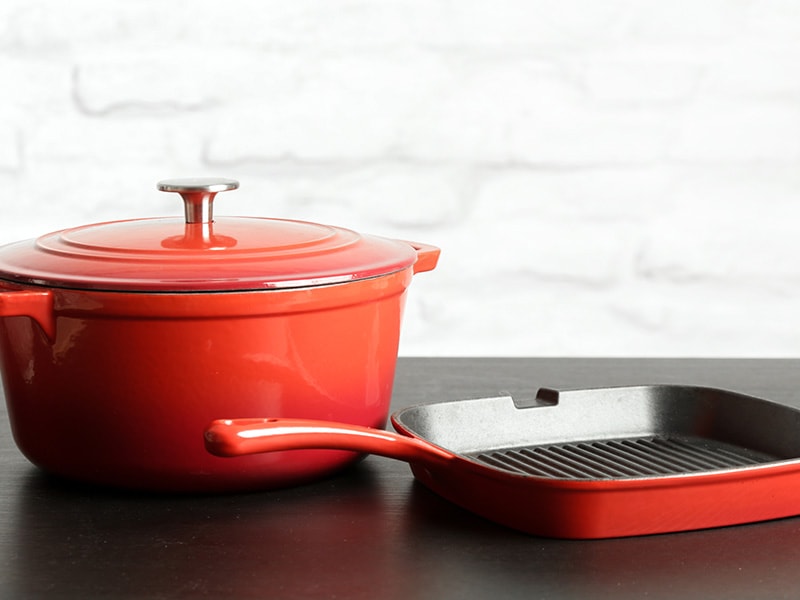
Think of enameled cast iron as the “upgraded” version of the traditional cast iron. At its core, it’s still the same carbon-iron fusion, but this time, the cookware comes coated with a layer of ceramic enamel.
This enameled coating makes seasoning unnecessary and adds more color to the cookware. You can now pick and choose between multiple colors to match the decorative theme of your kitchen.
Furthermore, you no longer have to worry about cooking alkaline or acidic foods as this material is non-reactive. “If the enameled version is so perfect, why should I bother using the old one?” you might ask. Well, here’s the catch.
Although the new glaze does bring a breath of fresh air to this age-old material, it’s also much more expensive! If you’ve been a fan of the classic cast iron’s affordability, its “modernized” cousin might not be a great choice for you.
Tramontina Enameled Cast Iron Covered Dutch Oven and Lodge Enameled Cast Iron Dutch Oven are great starting points if you want to try this material out. For a full-blown luxurious option, go for Le Creuset Enameled Cast Iron Signature Round Dutch Oven.
Pros
- Extremely durable and versatile.
- Great at retaining and conducting heat.
- Good for high-temperature cooking.
- No seasoning is needed.
- Comes in a variety of beautiful colors.
- Non-reactive and can be used to slow cook acidic or alkaline food with no problem.
- Resistant against rust
- Less sticky than traditional cast iron (before coating).
Cons
- Can be much more expensive than regular cast iron.
- Heating takes time.
- Quite heavy.
- Unlike its “big brother”, you can’t season enameled cast iron to create a non-stick surface.
- Some utensils can chip the enamel glaze. Opt for wooden, silicone, or wooden utensils to prevent this from happening.
Safe For & Best For
Safe For: It can do everything that cast iron can.
Best For: Frying, roasting, braising, simmering, sauteing, and searing. This material is also commonly used to make Dutch ovens – an excellent tool for cooking stews and chilies.
Cleaning & Maintaining Methods
Use soap and water to wash enameled cast iron. If you come across tough marks, soak the entire pan/pot into a soap-water mixture and rub gently with a scrub brush if you come across tough marks
Avoid using harsh cleaning detergents, tools, and steel wool.
Although you can clean cast enameled cast iron with a dishwasher, the machine can damage the coating if used too constantly.
A brief comparison between enameled cast iron and its big brother.
3. Aluminum
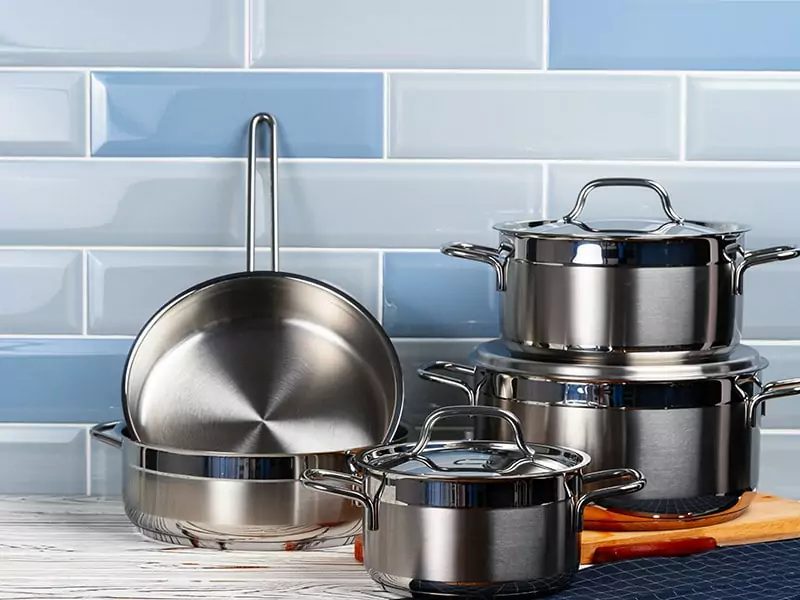
Aluminum is among the best heat conductors you can find. It’s also very cheap and lightweight. However, because this metal is so fragile and reactive, it doesn’t make good cookware on its own
Typically, manufacturers will integrate aluminum into their non-stick or stainless steel cookware to make use of this material’s outstanding conductivity. When combined with another metal, aluminum also makes for exceptional bakeware.
An enhanced version of the metal called hard-anodized aluminum solves many shortcomings that prevent aluminum from being a stand-alone cookware material. Keep reading to learn more about this subject!
Cooks Standard 12-Inch Professional Aluminum Nonstick Skillet Fry Pan and Tramontina Professional Aluminum Nonstick Restaurant Fry Pan are great bangs for your bucks. If you need a full set of cookware, check out Cuisinart Advantage Nonstick Cookware Set.
Pros
- Relatively cheap.
- Aluminum is very thermally conductive. It can heat up quickly and evenly.
- You can find aluminum in many types of cookware, such as stainless steel or non-stick.
Cons
- Aluminum lacks durability. If you expect a lifespan as long as that of cast iron, you’ll be disappointed.
- Reactive to acidic food. Pure aluminum will make your food taste metallic.
- Can lose shape when exposed to high cooking temperatures.
Safe For & Best For
Safe For: Oven, broiler, stovetop.
Best For: Aluminum cookware lined with a non-stick layer will work wonders in stir fry, eggs, vegetables, and pancakes. Keep high heat cooking away from this material, though. Also, it’s not great for browning or searing
Cleaning & Maintaining Methods
Allow the cookware to cool completely before rinsing. Drastic changes in temperature can cause aluminum to warp.
Clean it with dish soap, warm water, and a sponge. Make use of the brittle part of the sponge or a wooden spoon to remove stubborn spots.
To reduce discolorations, make a mixture of 2-3 tablespoons of vinegar or lemon juice and 1 quart of water. After that, boil the mixture inside the aluminum cookware for 15 minutes and watch all the stains disappear!
If you doubt the safety of aluminum pans, this explanation will give you the answer.
4. Hard-Anodized Aluminum
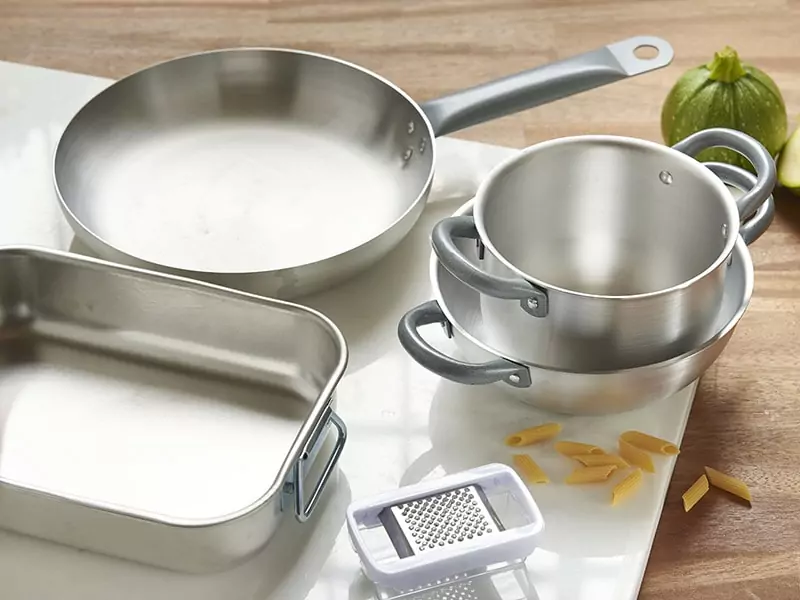
As mentioned above, hard-anodized aluminum is the answer to this metal’s soft and reactive nature. It’s much sturdier than pure aluminum and is no longer prone to acidic food thanks to the oxidized layer on the surface.
The electrolytic process of hardening aluminum was invented in 1968 by Ronald M. Kasperzak – the founder of Calphalon. He took inspiration from the aerospace industry, in which cookware is reinforced to better withstand warping and corrosion.
A glaze of non-stick material is often applied to hard-anodized aluminum cookware to improve ease of usage. Companies also combine “modified” aluminum with other metals, such as fully-clad stainless steel.
As the company that invented the anodizing technique, Calphalon provides a truckload of excellent hard-anodized kitchenware. For starters, you can’t go wrong with the Calphalon Premier Hard-Anodized Nonstick 11-Piece Cookware Set.
Try the All-Clad Hard-Anodized Nonstick Fry Pan Cookware Set if you just need some good frying pans.
Pros
- Much more durable than regular aluminum and is resistant to warping.
- Non-reactive.
- Good for stacking as it’s quite scratch-resistant.
- An excellent heat conductor.
- No more metallic taste, thanks to the non-stick coating.
- Can handle high heat cooking.
Cons
- Heavier than classic aluminum.
- Can be a bit expensive.
- Varied quality, depending on the brands.
- Some variants can’t be used on induction stovetops.
- Might lead to over-browning in sweet baked goods.
Safe For & Best For
Safe For: Oven, stovetop, and induction burners (not always).
Best For: Stir fry, eggs, vegetables, pancakes, and even sauteing or searing.
Cleaning & Maintaining Methods
Cleaning hard-anodized aluminum cookware is quite simple. Usually, you only need a standard set of dish soap, plastic scrub, and water. Just remember to stay away from steel wool and abrasive cleaners. A dishwasher is also a convenient cleaning option.
5. Carbon Steel
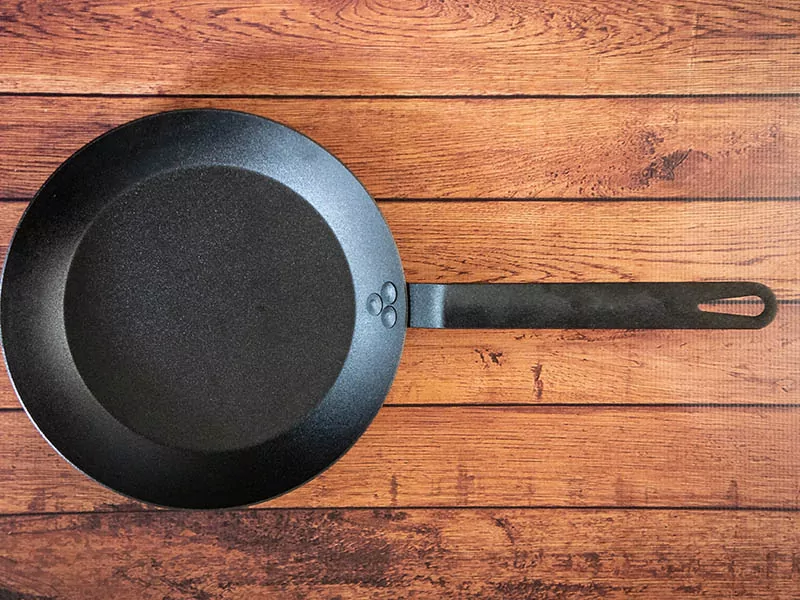
Like cast iron, carbon steel consists of carbon and iron. However, the iron to carbon is slightly different since 99 percent of this material is made from iron, and only 1 percent is from carbon. This change makes it lighter and easier to use than cast iron, albeit thinner.
A common question that people have regarding this material is whether carbon steel is safe for making cookware. Since it comes from the same components that make up cast iron, rest assured that it’s perfectly safe for cooking. However, like cast iron, you’ll need to coat it first.
With proper care, carbon steel cookware will last for a decent amount of time and will age like fine wine. The material comes in various forms, including woks, baking and frying pans, skillets, pots, and roasters. The first two are the most common ones.
In addition, many carbon steel baking pans are manufactured coated with a layer of stick-resistant or non-stick compounds to reduce the hassle of maintaining. While frying pans are also made from this metal, they’re a bit trickier to come by.
If you need some reliable carbon steel pans, Merten & Storck Frying Pan (available in many sizes) is a popular choice for home cooks at any level. For an affordable, pre-seasoned carbon steel paella pan, look no further than BK Black Steel.
Pros
- Durability. Carbon steel cookware will last for a long time if cared for properly.
- Comes in many forms, from woks, pans, to skillets, pots, and roasters.
- Much lighter than cast iron.
- Affordability.
- Response quickly to heat.
Cons
- Acidic foods like lemon or tomatoes can harm the coating.
- Prone to discoloration and rusting.
- A little hard to clean and maintain.
- Requires coating regularly.
- Not as good as cast iron in heat retention.
Safe For & Best For
Safe For: Oven, stovetop, and broiler thanks to its high heat tolerance.
Best For: Almost every recipe, especially broiling, searing, and browning. Works great when cooking meats, omelets, vegetables, layered and regular cakes, bread.
Cleaning & Maintaining Methods
Avoid using the dishwasher to clean carbon steel cookware. Also, don’t submerge it in water and soap. To clean this material, wash it gently with water and soap. Use a sponge or plastic scrub to remove stubborn spots. Dry before storing and reseason when needed.
6. Impact-Bonded Stainless Steel
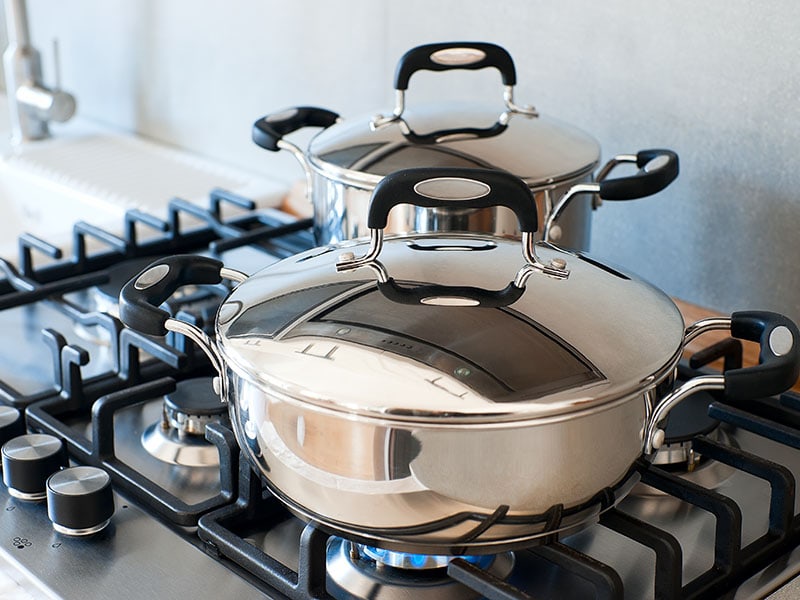
If you need to cook acidic foods on a regular basis, stainless steel is an excellent choice as this metal is completely non-reactive. Not only that, but it’s also durable, practically immune to rust, scratches, and dents. Plus, it won’t give your food a weird metallic taste or color.
However, there’s a catch. On its own, the material is terrible at conducting heat, meaning that you won’t have a good time cooking with a pure stainless steel pan. Fortunately, most stainless steel cookwares are “enhanced” with other metals to counteract this issue.
The first method is called impact-bonding, which combines aluminum or copper base with stainless steel to increase its heat-transmitting ability. The conductive plate might be placed at the bottom of the pan or in-between layers of stainless steel.
With the appearance of aluminum, you might be wondering if stainless steel cookwares are the same as hard-anodized ones. While there are indeed some similarities, the former is often more expensive and more durable.
There are numerous stainless steel cookware brands to choose from. This 10-piece set from Calphalon has everything you need for your kitchen. Anolon Nouvelle Stainless Steel Cookware Pots and Pans Set is an excellent choice if you want to invest a little more.
Pros
- Non-reactive.
- Quite cheap.
- Many brands to choose from.
- Lightweight.
- Transmits heat quite effectively, especially at the bottom.
Cons
- Doesn’t provide even heating on the sides.
- Might be sticky if it isn’t heated properly.
- Stuck-on spots are a little hard to clean.
- Not as sturdy as other more expensive choices.
- Not suitable for cooking liquid or sauces due to uneven heat distribution on the sides.
Safe For & Best For
Safe For: Oven, stovetop, and broiler.
Best For: Frying, browning, searing.
Cleaning & Maintaining Methods
Use soap and water to gently wash the surface. To remove stuck-on spots, fill the cookware with water and boil for about 15-20 minutes to loosen them up. Then, use a wooden spoon to scrape them off. Alternatively, use a specialized stainless steel cleaner or baking soda.
7. Fully Clad Stainless Steel
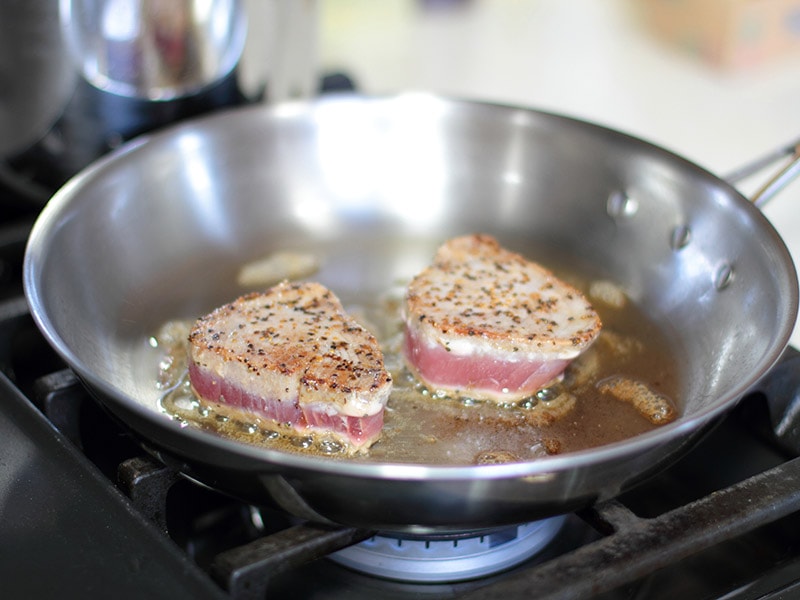
Similar to impact-bonded base stainless steel, fully clad stainless steel is also made by bonding the metal to other conductive materials. However, manufacturers will take a step further to completely cover the cookware with this metal fusion, not just the bottom.
As a result, it can circulate heat more evenly than bonded stainless steel and is also more enduring. Typically, there’ll be at least three layers (tri-ply), including one layer of stainless steel on the surface, a conductive core, and another stainless steel outer.
Higher quality cookwares might have up to five or seven layers of metal and use a copper core instead of aluminum for better thermal distribution.
As mentioned above, expect to pay a higher price for full clad stainless steel cookware. However, I can ensure that you won’t regret investing in this Heritage Steel 10 Piece Cookware Set with a 5-ply construction.
If you just want to get a feel for this material without spending too much money, give this Cook N Home Tri-Ply Clad Stainless Steel Sauce Pan a try.
Pros
- Excellent at evenly and quickly conducting heat.
- Will last for a long time.
- Responsive to temperature changes.
- Multi-purpose. You can use fully clad stainless steel cookware for every recipe.
- Suitable for many types of cooktops.
Cons
- Much more expensive than partly clad stainless steel.
- Food might stick to the surface.
- Requires good cooking technique.
- Might be hard to clean completely, especially when there are food pieces stuck on it.
Safe For & Best For
Safe For: Oven, stovetop, and broiler.
Best For: Pretty much any cooking recipe and technique, especially browning and searing.
Cleaning & Maintaining Methods
Similar to impact-bonded base stainless steel.
A quick and thorough comparison of the two types of stainless steel.
8. Copper
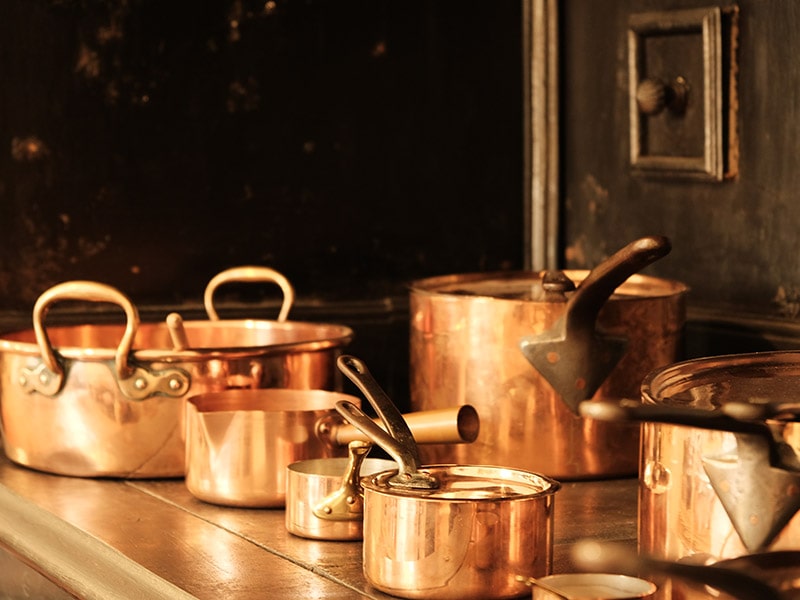
A set of copper cookware is truly a sight for sore eyes. Being a precious metal, copper is gleaming with novelty and will add a luxurious look to your kitchen.
In addition, it’s the most responsive cookware material on the market and can conduct heat more evenly than any other metal. Does this mean that copper makes for the ultimate, most well-rounded cookware? Well, yes, but not always.
First, copper isn’t that good of a stand-alone material since it will react with acidic ingredients and give your food a yellow-ish hue and somewhat metallic taste. For this reason, it needs to be fused with another nonreactive metal like stainless steel or tin.
While some people might be torn between stainless steel and copper cookware, the best option lies somewhere in-between. While tin used to be the preferred lining material for copper, stainless steel is much more popular nowadays, thanks to its superior durability.
A word of caution, you’ll need to pay a lot for copper cookware. In addition, cooking with them requires a certain level of skills since this metal is very quick to heat up and cool down. Learning how to use them is well worth it, though.
While non-lined copper cookwares are also available, they are used strictly for sugar cookery and not everyday cooking.
Lagostina Martellata Hammered Copper Cookware Set is a great starting point for people that are curious about copper cookware. Try this Hestan – CopperBond Collection – 100% Pure Copper Skillet once you’re ready to invest in a more premium piece.
Pros
- Beautiful pieces of cookware that will light up your kitchen.
- Excellent at conducting heat quickly and evenly.
- Very responsive.
- Will not rust.
- Easy to clean.
Cons
- Reactive to specific kinds of food.
- Needs regular maintenance and polishing.
- Expensive.
- Not the best choice for high-heat cooking.
- Can’t be used on an induction top.
Safe For & Best For
Safe For: Oven, stovetop, and broiler.
Best For: Simmering, frying, sauteing. When you’ve mastered using them, you can precisely control the temperature of fish, caramel, fruit flambe, and sauce recipes.
Cleaning & Maintaining Methods
Wash and scrub gently with water, soap, and a plastic brush. Polish using copper cookware cleaner or leave to age naturally if you prefer a more rustic, patina aesthetic. Avoid strong cleaners and steel wool.
7 Non-Metal Cookware Materials To Try Out
In addition to stainless steel, copper, or carbon steel, non-metal cookware made from ceramic, clay, glasses, and many more are also well-loved among the home cook community. Keep scrolling to learn about these wonderful materials!
9. PTFE (Non-Stick)
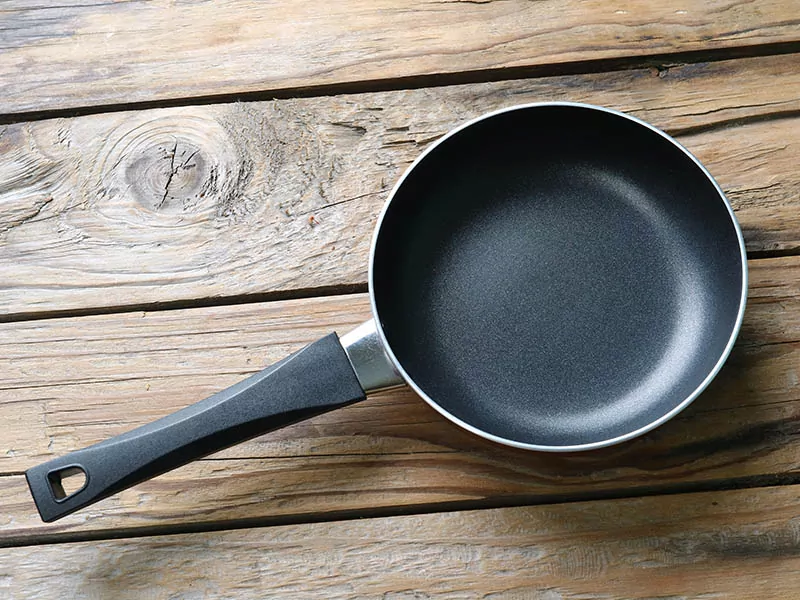
PTFE (polytetrafluoroethylene) is a synthetic material that creates a non-stick surface for various kitchenware. The base metal of PTFE-coated cookware might vary depending on the brand, with the most common ones being anodized aluminum and stainless steel.
Teflon, the brand that has commercialized and popularized PTFE, is currently the number one manufacturer in making non-stick cookware. As a result, products lined with this material are usually called Teflon.
While PTFE is undoubtedly cheap and functional, there have been some concerns over its safety in recent years. However, as long as you keep the cooking temperature below 500 degrees Fahrenheit, you shouldn’t have to worry about anything.
When overheated, though, the non-stick coating might break down and release toxic gas and compounds. Breathing in those gases might result in polymer fume fever, with flu-like symptoms such as chest discomfort, malaise, and fever.
Worst, tiny bits of PTFE might get into your food over time. Although there’s been no clear evidence that these flakes can cause long-term harm to your body, you’d be better off avoiding them.
If you’re on a budget, PTFE-coated products are your best options. You can’t really beat T-fal Signature Nonstick Dishwasher Safe Cookware Set when it comes to cheap yet high-quality cookware.
This 10-Piece Stainless Steel Cookware Set from Cook N Home is another bang for your bucks.
Pros
- Non-sticky.
- Light and cheap.
- You can use them in many recipes.
- Cleaning is effortless.
- An excellent heat conductor when combined with stainless steel, copper, or aluminum.
Cons
- Not very durable. Expect to replace your PTFE cookware in less than 5 years.
- Might release toxic compounds at high temperatures.
- Prone to warps.
- Not a natural material.
Safe For & Best For
Safe For: Cooking under 500 degrees Fahrenheit like on a stovetop and, in some cases, the oven.
Best For: Eggs, fish, vegetables, crepes, pancakes, stir-fry, curries, and other delicate foods.
Cleaning & Maintaining Methods
Use water, soap, and a soft sponge to clean PTFE-coated cookware. To get rid of stuck-on spots, scrub gently using a plastic scrub brush. Avoid strong cleaners and steel wool.
You can save time by using a dishwasher but remember that doing so can wear down the coating.
Did you know that Teflon was created by accident?
10. Ceramic (Non-Stick)
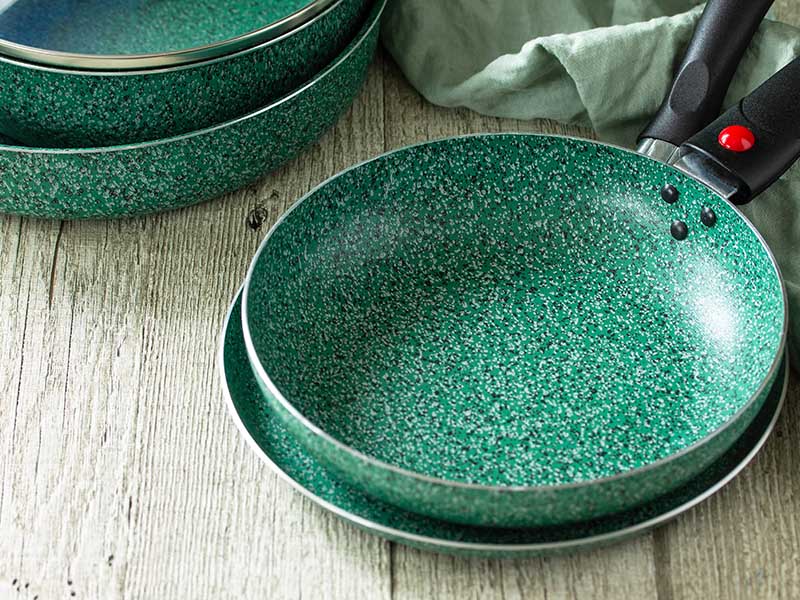
If you dislike the synthetic nature of PTFE but still want a cheap, reliable, and non-stick piece of cookware, then look no further than ceramic. Since it is derived from natural components, ceramic is much more eco-friendly than its PTFE counterpart.
By utilizing a process called sol-gel, companies have created a sand-based silicon layer that effectively prevents food from sticking to the cookware surface. You’ll find this coating in an array of styles and colors.
Technically speaking, this lining isn’t really ceramic. However, it is commonly commercialized under this name due to its prominent glossiness and similar characteristics.
Similar to PTFE, you should keep ceramic away from high temperatures. Although it won’t emit any poisonous gas, excessive heat can affect its non-stick potency.
Ceramic cookware is the best way to add some colors to your kitchen for cheap. GreenPan Chatham Hard Anodized Ceramic Nonstick Set comes in a basic gray color, while GreenLife Soft Grip Ceramic Nonstick Set is available in blue, red, turquoise, and many more.
Pros
- Non-stick.
- Non-toxic.
- Cheap and light.
- Eco-friendly.
- Comes in many styles and colors.
Cons
- Not very durable.
- Prone to scratching. The ceramic-like surface scratches quite easily, thus decreasing its non-stick attribute. Use nylon or wooden utensils to prevent this.
- Inconsistent and uneven heating.
- Not ideal for browning and searing.
Safe For & Best For
Safe For: Similar to PTFE-coated cookware.
Best For: Similar to PTFE-coated cookware. In addition, feel free to use it to cook acidic food.
Cleaning & Maintaining Methods
Similar to PTFE-coated cookware.
11. Stoneware
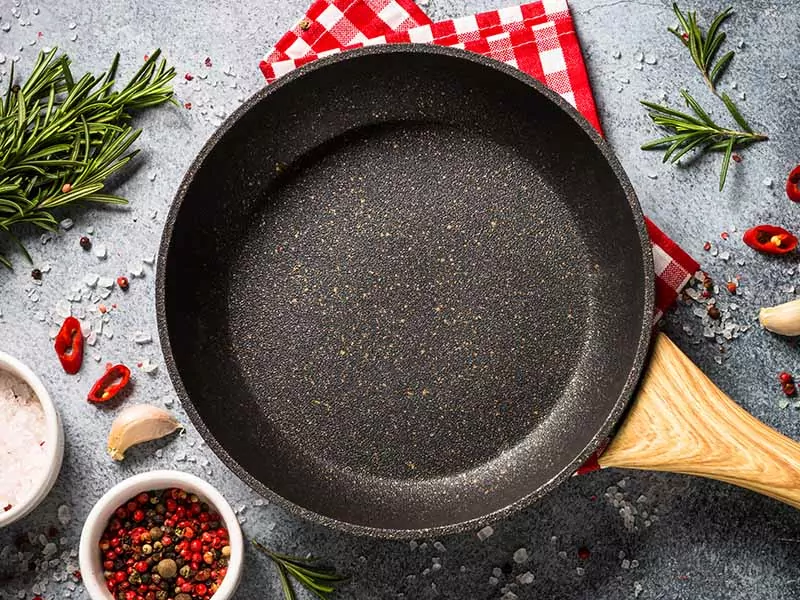
Nothing screams classic and old-school material like stoneware. Despite its age-old usage, it’s still among the best materials for making cookware, especially ones that are used for oven baking.
In fact, many people only swear stoneware when it comes to the vessels for their baked goods. Not only do they make the food taste much better, but these age-old goods also come in various shapes and sizes.
From savory dishes like casseroles, lasagna, pizzas, pasta to sweet delights like bread puddings, custards, and brownies, you can use stoneware for all of them.
In recent years, stoneware has made its way to gas and electric stovetops, thanks to the creativity of some manufacturers.
Think of this modernized version as a long-lost brother of the iron cast. Much like the iron cast, you can season them to form a nonstick surface. More importantly, they’re lighter, non-reactive, and can even be put in a dishwasher!
Some cheap stoneware used to contain lead in them. Although this is pretty much a thing of the past now, it’s always better to be cautious.
Michelangelo Pots and Pans Set is the perfect starting point for your stoneware journey. In case you need to treat yourself to some casseroles, check out this beautiful Le Creuset Stoneware Covered Rectangular Casserole.
Pros
- Durability.
- Can be seasoned to create a non-sticky surface.
- Lighter than cast iron.
- Makes outstanding vessels for baked dishes.
- Non-reactive, non-toxic.
- Comes in many shapes and sizes.
Cons
- Requires specific maintenance techniques.
- Might contain lead (unlikely)
Safe For & Best For
Safe For: Oven, stovetop.
Best For: Clay and stoneware are the ultimate options for making baked goods in general. Make sure to pick the right types for your purpose.
Cleaning & Maintaining Methods
It’s best to follow the manufacturers’ instructions since your piece of cookware might require particular ways to clean and maintain. As a general rule of thumb, avoid heat shock as doing so will cause it to crack.
For example, do not fill the cookware with cold water or put it directly on a cold platform while it’s still hot.
12. Silicone
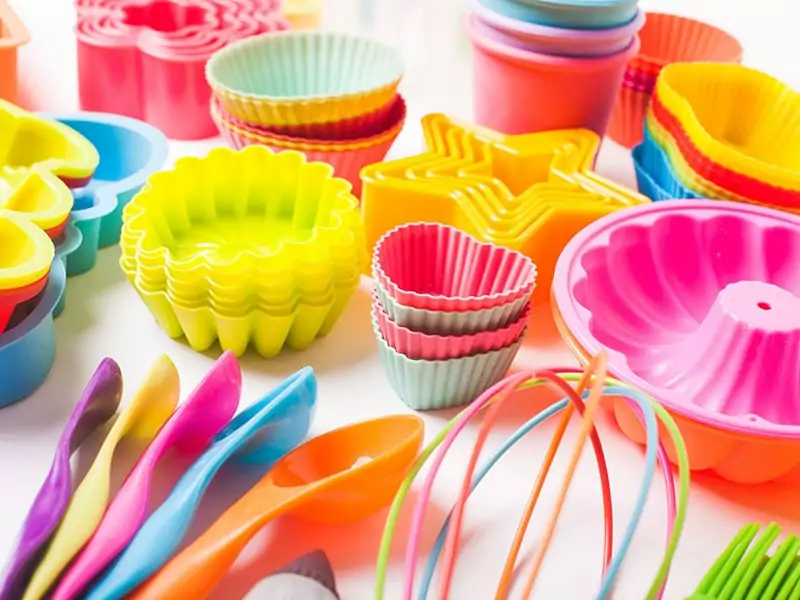
Apart from stoneware, silicone is another must-have cookware category for lovers of baked recipes. Having a silicon mat or pan liner will make baking so much easier, both outside and inside the oven.
The liners made from this material prevent your pizzas, cookies, and galettes from sticking, which, honestly, is a nightmare for any baker. The nonstick nature of silicon also allows you to turn them into perfect dough rolling mats.
If you’re planning to cook up some mousse bombs, silicon molds and muffin pans will be your trustworthy companions.
One downside of this cookware is it can sometimes be a little hard to clean. Opt for simple, untextured pans or molds to make cleaning less troublesome.
This Classic Cuisine Silicone Bakeware Set should have you covered with all your basic baking needs. If you want your foods to have more appealing shapes, definitely try this 3 Packs Flowers Silicone non-Stick Mold.
Pros
- Mostly nonstick.
- Excellent for making baked goods.
- Easy to store.
- Dishwasher-safe.
- Inexpensive.
Cons
- Not good at conducting heat.
- Can be hard to clean completely.
- Can be challenging to remove certain foods from the mold.
- Not good at browning baked goods.
Safe For & Best For
Safe For: The oven.
Best For: Baked goods that don’t need to brown well, such as bread, cakes (light-colored), and muffins.
Cleaning & Maintaining Methods
Clean your silicone cookware with water, soap, and a soft sponge. Alternatively, you can put it in a dishwasher.
All you need to know about silicone and its safety will be included here.
13. Glass
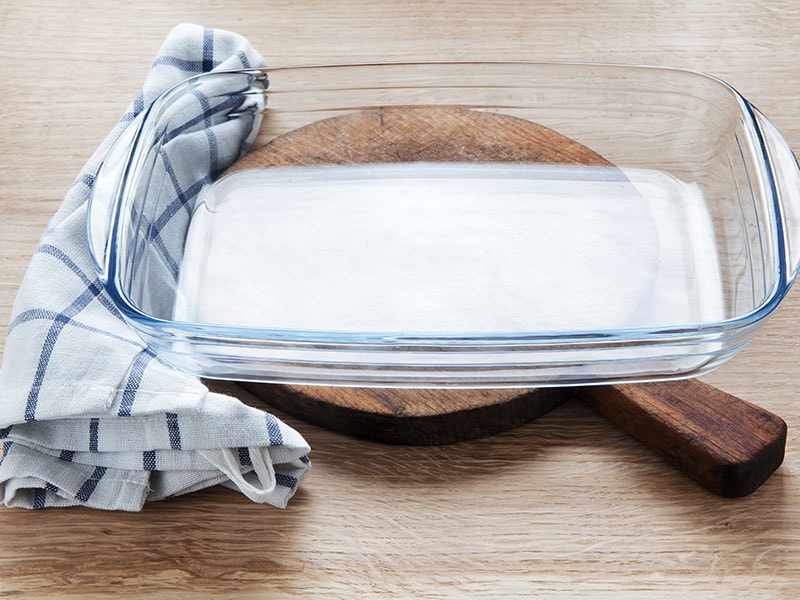
Last but not least, glass cookware is your best bet for making well-brown baked goods, thanks to its non-reactive and heat-conductive nature.
To utilize this material to the fullest, try making casseroles or crusty pies with it. Moreover, glass cookware also works decently in roasted meat and vegetable recipes. Also, feel free to store your food in a glass pan after cooking.
That said, you might want to avoid baking sugary sweets in glass vessels since they can sometimes over-caramelize. In addition, it’s not a good idea to broil food in glass cookware since high heat might cause them to shatter.
A highly-affordable set of Oven Safe Glass Baking Dish is a quintessential for every kitchen. However, this 8-Piece Deep Glass Baking Dish Set with Plastic lids will be a better choice for avid bakers.
Pros
- Good at conducting heat.
- Non-reactive.
- Cheaper than ceramic.
Cons
- Might cause sugar to over-caramel.
- Not ideal for broiling foods.
Safe For & Best For
Safe For: The oven.
Best For: Baked goods that require good browning, roasted meats, and vegetables.
Cleaning & Maintaining Methods
Cleaning glass cookware is no hassle. You can throw them in a dishwasher as many times as you like or wash them with soap, water, sponges, or plastic scrubs. The only thing you need to keep in mind is to let your pans cool completely before cleaning.
14. Pottery (Clay)
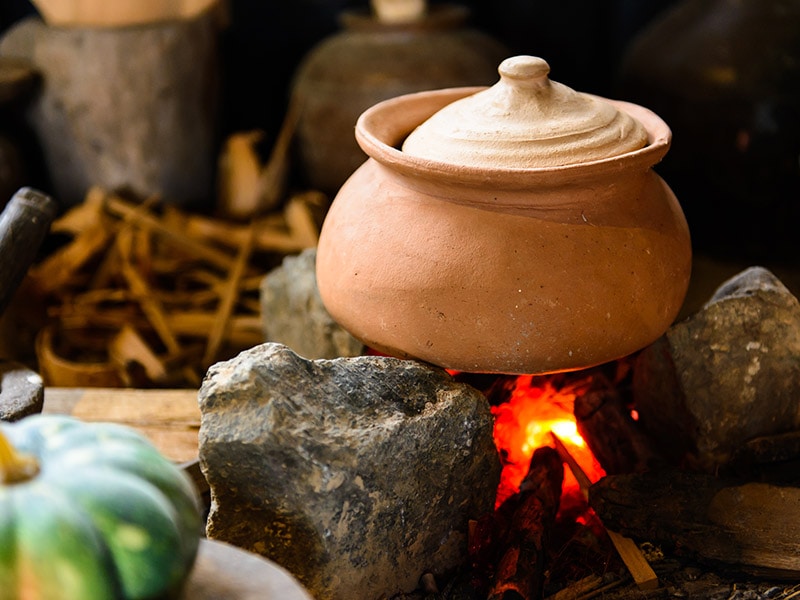
Much like stoneware, clay (or pottery) is another old-fashioned material that is still going strong today. Although unheated porcelain is soft and malleable, it will harden permanently and become one of the most long-lasting materials once baked at the right temperatures.
Apart from being reliable, pottery cookware is also naturally non-reactive and is great at evenly conducting heat. They’re perfect for cooking on a coal fire pit or baking in the oven.
Many seasoned chefs say that slow-cooked dishes like curries or biryani will taste more delicious when cooked in earthenware. This is because the material is porous, which allows the spices and herbs’ aromatic goodness to blend better with other ingredients.
You might not believe this, but you’re supplementing your body with minerals like magnesium, iron, phosphorus, and calcium just by using pottery pots. Additionally, clay’s alkaline nature will also neutralize the acidity in your food, thus making it easier to digest.
That said, the material still has some disadvantages. Although earthen pots are known to last for a long time, they also crack easily, especially under high heat. Besides, since clay is good at absorbing heat, you’ll need to be careful not to burn your hand when touching it.
More importantly, glazed clay pots, which take up a large percentage of the market, are not exactly the healthiest option. There’ve even been records of lead toxicity from this particular material.
Reston Lloyd has a clay pot with an unglazed lit if you’re worried about the lead content. Want to “trick” your child into cooking, check out this Cartoon Pattern Stew Pot from Ahuonel.
Pros
- Excellent heat conductor.
- Non-reactive.
- Can neutralize acidity.
- Long-lasting.
- Supplement the body with essential minerals.
- Versatile.
Cons
- Glazed materials can have harmful effects on health.
- Prone to cracking if not handled well.
- Might burn your hand while cooking.
Safe For & Best For
Safe For: Cooking directly on fire, the oven, stovetop (need seasoning beforehand).
Best For: Slow-cooked dishes like curries and biryani.
Cleaning & Maintaining Methods
Because earthenware is covered in tiny pores, soap or dishwashing detergent is not the best choice to clean them. I mean, you don’t want any left-over soap to get stuck in the pores and go into your food.
Instead, fill them with hot water and clean them with a brush. Add some salt or baking soda to the water and scrub the stubborn bits away.
15. Glass-Ceramic
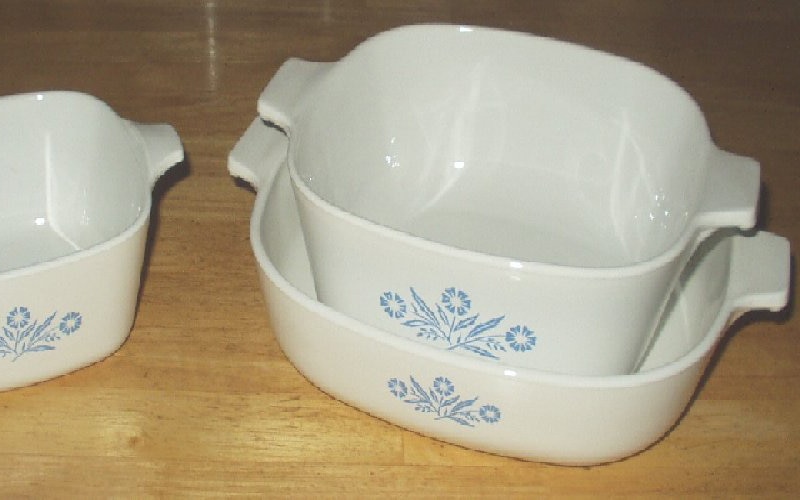
As the name implies, this material is a hybrid between glass and ceramic. Since glass is naturally non-stick, the added ceramic is mainly used to improve durability and strength.
Furthermore, it has a very low level of thermal expansion that’s close to zero and sometimes even reaches a negative coefficient. As a result, glass-ceramic is much more resistant to thermal shock than standard glass.
In other words, you don’t have to think twice about moving a glass-ceramic cookware from a freezer to your stovetop! At first glance, some people might not realize that they’re actually glass, though, since glass-ceramic is opaque or opalescent rather than translucent.
You’ll often see this material in Pyroflam and CorningWare products. For example, take a look at this 10-piece bakeware set and these casseroles cooking pots from CorningWare.
Pros
- Low thermal expansion coefficient, making it more resistant to thermal shock.
- Non-reactive.
- High impact resistance.
Cons
- More expensive than glass cookware.
Safe For & Best For
Safe For: The oven, stovetop.
Best For: Baked goods that require good browning, roasted meats, and vegetables.
Cleaning & Maintaining Methods
The same as ceramic cookware.
Pick The Right Material For Your Needs
The 15 cookware materials listed above should be enough to suffice your every need in the kitchen. With all the information provided in this post, I hope you’ll be able to pick the right one for your next recipe.
What are your preferred types of cookware? Don’t be shy; share your thoughts with the other readers in the comment section. By the way, if you know someone who might benefit from this post, please send it to them!
